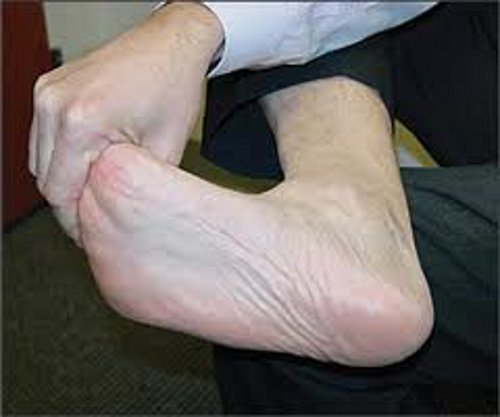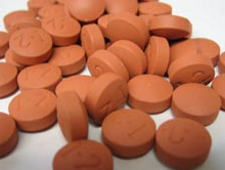 You wake-up in the morning, swing your feet off the bed, take your first steps, and, “wham!” the pain stabs across the bottom of your foot.
You wake-up in the morning, swing your feet off the bed, take your first steps, and, “wham!” the pain stabs across the bottom of your foot.
“What was that?” you wonder, and you are not alone. Though figures are difficult to come by, some 360,000 Google searches a month in 2009 demonstrates that Plantar fasciitis is becoming a serious and growing problem.
Plantar what?
Plantar fasciitis, as defined by the Mayo Clinic, “is one of the most common causes of heel pain.” The condition involves “pain and inflammation of a thick band of tissue, called the plantar fascia, which runs across the bottom of your foot — connecting your heel bone to your toes.”
That stabbing pain felt in the heel of the foot during the first steps taken in the morning is one of the most common symptoms, and most patients comment that the pain decreases as the foot loosens up during the day, but may reoccur after standing for long periods, or sitting for a long time. The symptoms are gradual, developing over time, and usually just one foot is affected.
Who Gets Plantar Fasciitis?
 The injury is common among runners, especially those who place lots of stress on their arches, or who may not wear the right type of shoe. In addition, people who are overweight and pregnant women are also at risk.
The injury is common among runners, especially those who place lots of stress on their arches, or who may not wear the right type of shoe. In addition, people who are overweight and pregnant women are also at risk.
All of these people have one thing in common: placing undue stress upon the feet. The plantar fascia, a bowstring supporting the arch in the foot, normally acts as a shock absorber. Yet when the bowstring is stressed, the fascia can tear slightly. Repetitive stress on the foot, usually from tearing and overstretching, can create irritation or inflammation in the fascia.
Most people who get this condition are middle-aged, between the ages of 40 and the age of 60, and are women. As mentioned above, plantar fasciitis is a common problem among runners, especially long-distance runners, but can also be a condition seen in ballet dancers and women who participate regularly in dance aerobics.
Other factors that put people at risk of this painful condition include being flat-footed, having a strange gait, or a high arch; being overweight (which places extreme stress on the plantar fascia); and having a job that requires lots of standing and walking such as assembly line workers, teachers, clerks, and waitresses.
Finally, it’s all about the shoes. Shoes can play a huge role in the overall health of your foot. If your shoes have thin soles, are loose, have little arch support, or do not properly absorb shock, and then those shoes are not protecting your feet.
Shoes that are old and worn should be tossed and, when looking to buy a shoe, especially a running shoe, you’ll want to look for one with the padding, sole thickness, and arch support that you’ll need. You might have to pay more but your feet will thank you. For you women who regularly wear high heels, just know that you could be damaging your Achilles tendon, causing irritation around the tissue surrounding your heel.
How Can You Treat Plantar Fasciitis?
 According to the Mayo Clinic, around 90% of people afflicted with plantar fasciitis get better with a fairly conservative line of treatment. The recovery time is usually two weeks but, depending on the severity of the injury, the time could be lengthened to several months.
According to the Mayo Clinic, around 90% of people afflicted with plantar fasciitis get better with a fairly conservative line of treatment. The recovery time is usually two weeks but, depending on the severity of the injury, the time could be lengthened to several months.
Medications
Over the counter anti-inflammatory drugs, such as ibuprofen (found in brand medications such as Advil and Motrin), and naproxen (found in Aleve), are often prescribed to help with the pain and inflammation caused by the condition. These drugs, while relieving pain, do not treat the underlying condition.
Another common medication used is corticosteroids. This type of medication, according to the Mayo Clinic, is delivered “through a process called iontophoresis, in which a corticosteroid solution is applied to the skin over the painful area and the medication is absorbed with the aid of a no painful electric current.”
Therapy
Your doctor might refer you a physical therapist who will help you learn exercises that help stretch the Achilles and the plantar fascia as well as strengthening your lower legs. These exercises will stabilize your ankle and heel. If you are constantly on the go, your PT might teach you how to tape the bottom of your foot to stabilize the muscles.
Other fixes include night splints and arch supports. In extreme cases, you might need sound wave therapy or even surgery, which is generally used as a last resort when all other treatments are exhausted and the pain has still not diminished.
Treatments for Athletes
When an athlete gets plantar fasciitis, the temptation is to work through the pain because any time missed, whether it is time off from running, biking, or time spent in the training room and not on the playing field, can mean the difference from winning a competition, making a team, or winning a game. Yet, working through the pain is the worst thing possible.
Athletes, like any of us, need to rest the foot until the pain decreases. Using the foot, whether walking, standing for long periods of time, or continuing with athletic activities, will only aggravate the injury, making the pain, inflammation, and irritation worse.
What happens when the coach is putting pressure on you to get back on the field, or the race or meet is coming-up and you really need to train? Effective plantar fasciitis taping can go a long way to making things tolerable and, while you are not resting the foot, you are giving the tendons rest by supporting them properly.
The best taping technique, according to sportsinjuryclinic.net, is when tape is “applied in strips across the plantar fascia taking the stress off the foot which healing to take place.” Athletes can also apply ice or cold therapy to reduce pain and swelling.
Finally, according to sportsinjuryclinic.net, “stretching the plantar fascia is an important part of treatment and prevention. The plantar fascia tightens up making the origin at the heel more susceptible to stress.” Stretching can alleviate that stress, thereby reducing the chances of injury.
So, the next time you have been out for a long run and wake-up with a sharp, stabbing pain in your foot, you’ll know to get some rest, get some ice, and make sure to stretch and apply tape. With the proper care and treatment, you’ll be back in the game, in the race, or even on the job relatively quickly!